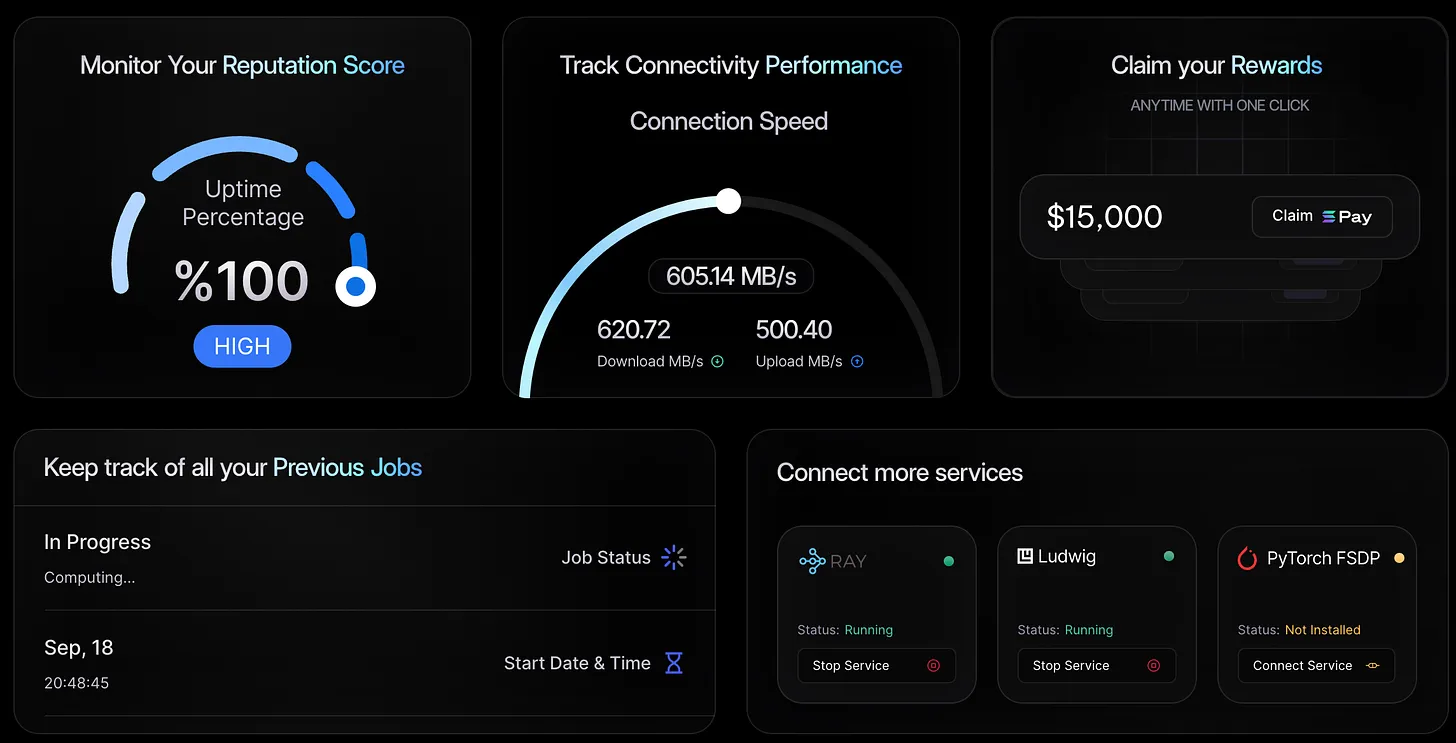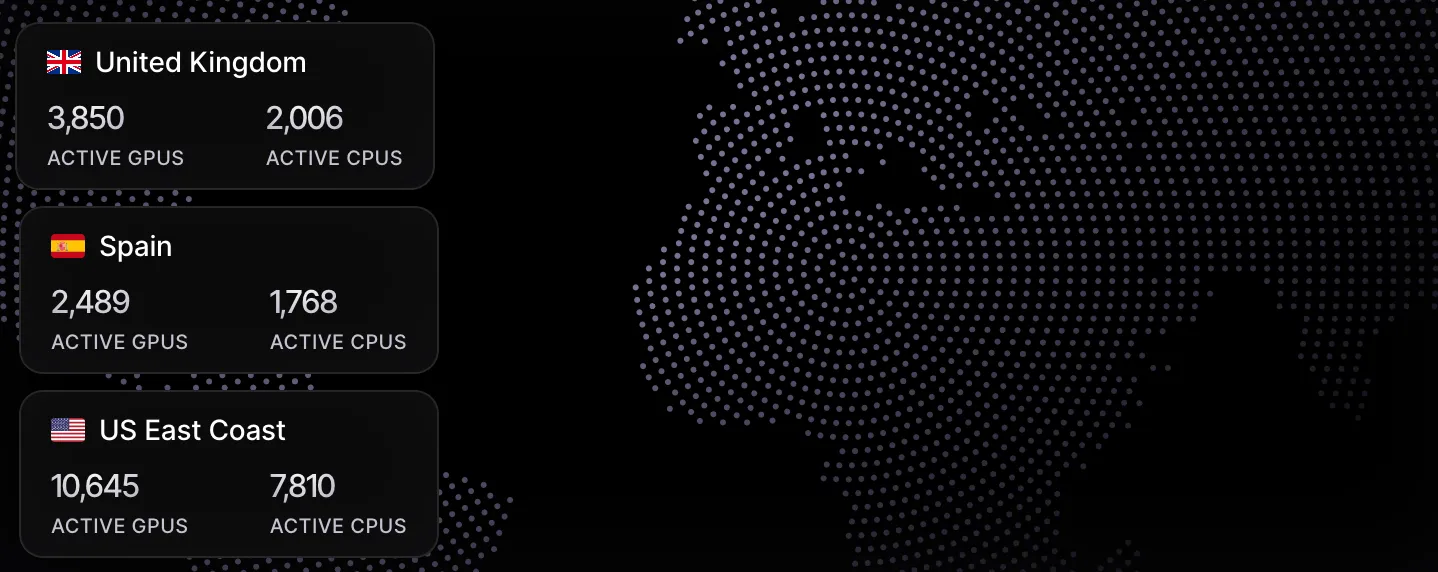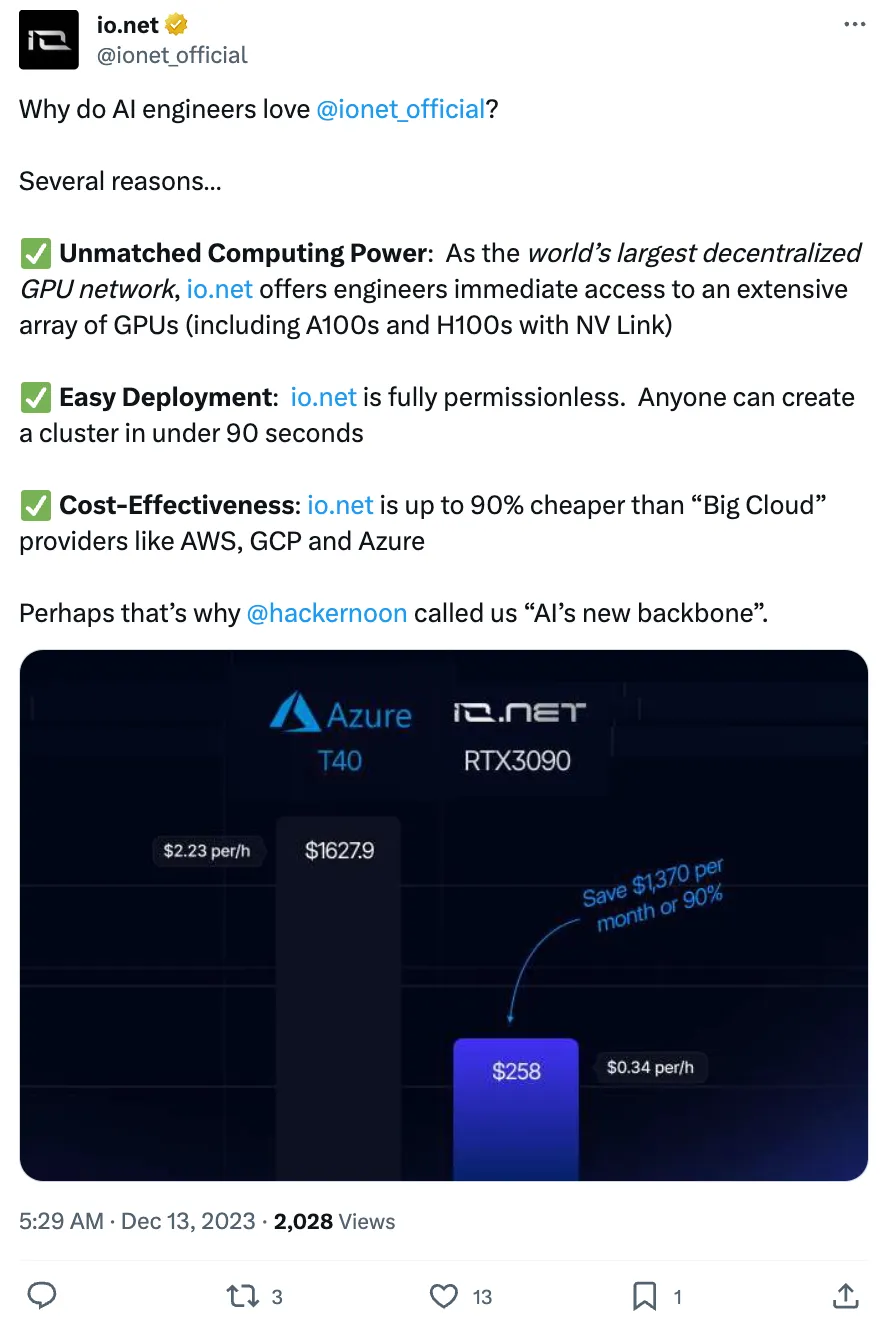Author: Revelo Intel
Compiled by: Deep Tide TechFlow
DePIN, as one of the key narratives, has quickly gained popularity, especially on Solana. With significant progress being made by projects like Render and Helium, DePIN and similar projects are worth researching.
In the current digital age, blockchain technology is increasingly becoming a key factor driving innovation and efficiency. In this article, we will delve into io.net - a revolutionary project on the Solana blockchain that reshapes our understanding and use of GPU computing by integrating idle GPU resources.

Project Background
- io.net is a DePin protocol built on Solana, helping to address coordination issues among GPUs.
- Similar to how DeFi disrupts traditional finance by eliminating intermediaries and pooling liquidity, io.net aims to do the same for computing resources. It provides a coordinated solution where all participants have incentives to work together.
- io.net has identified inefficiencies in the market, such as supply constraints and centralized control of GPUs. By addressing these issues, io.net aims to offer products cheaper than centralized services.

What is DePIN?
- DePin refers to replacing existing infrastructure work with hardware investment and token incentives.
- Examples include 5G networks, routing 5G through people, and replacing traditional telecommunications infrastructure.
- Hardware participation in the network brings value to people.
Why is DePIN developing on Solana?
- Solana's friendly and supportive community has fostered growth and collaboration. Solana provides tools for microtransactions, data storage, and other functionalities. In summary, the combination of community support and useful tools makes Solana an ideal platform.
- DePin represents the use case of blockchain.
- The GPU field is monopolized by industry giants, highlighting the necessity for disruption.
- DePin projects have the potential to bring significant changes to various industries.
More and more crypto applications are focusing on integrating off-chain tokens with real-world economic output, especially crypto applications based on Solana.
- Render is creating a peer-to-peer network that allows GPU rendering tasks to utilize idle GPUs. Rendering is actually one of the sources of aggregated GPUs for io.net.
- Hivemapper aims to develop the world's latest AI-driven maps, rewarding drivers using dashcams with $HONEY tokens.
- Helium incentivizes users to provide local hotspot coverage in exchange for local $HNT tokens.
- Shdw Drive is a decentralized storage solution involving native $SHDW, similar to Filecoin, Arweave, and others.
The Team behind io.net
- Ahmad Shadid is the founder and CEO of io.net. Ahmad mentioned that before creating io.net, he developed a machine learning model to detect institutions filling orders in the market and hiding them. He expanded the model to cover 2000 stocks and 150 cryptocurrencies.
- Tory Green is the COO and CFO of io.net, having joined full-time three months ago. His career began in corporate, including positions in banking, private equity, and corporate strategy. He co-founded a digital publishing company in the web2 era and transitioned from an investor to an operator, helping portfolio companies with sales, marketing, finance, operations, and strategy. He served as CEO and CFO at Hum Capital for nearly two years, a machine learning company. During this time, he gained a deep understanding of the AI field. He has been interested in cryptocurrencies since 2016.
- Tory mentioned that he realized io.net is a solution that deeply addresses practical problems. He was impressed by Ahmad's wisdom, vision, and drive. Due to his belief in its potential, he joined io.net full-time three months ago.
Comparison of io.net with Traditional Competitors
- Compared to competitors, the price of io.net is a significant advantage, but there are other differences.
- io.net provides a choice: users can recreate a data center similar to AWS (Amazon Web Services) with comparable performance. Users can move the data center closer to them to reduce latency, providing a competitive advantage for trading scenarios.

- Tory mentioned that the user experience of io.net is superior to deploying on AWS, which typically involves complex processes and authentication, taking months.
- Ahmad mentioned that the GPU speed offered by io.net is faster than 40,000 or 80,000 GPUs of Lambda Cloud (Amazon's cloud computing).
- Due to faster internet speeds and better network performance, startups are transitioning from Lambda Cloud to io.net.
- Small details like internet speed are important - with less network congestion, providers with fewer servers can offer higher speeds.
- io.net aims to capitalize on the profitability of AI computing, similar to AWS. By attracting more GPU suppliers, io.net can provide continuous profits to suppliers and expand its customer base.
- Ahmad mentioned that customers don't have to migrate everything from AWS, but can benefit from lower prices, comparable performance, and improved user experience, with the network's growth potentially leading to the establishment of cloud-sourced data centers and other resources.

Balancing Between Competitors and io.net
- Traditional competitors may argue that io.net lacks specific features such as automatic deployment, CI/CD, and API defense, which they have spent years developing.
- Ahmad pointed out that io.net has already built these features within the ML (machine learning) industry for training and inference purposes. He added that while there may be some shortcomings in the current scope of available features, the overall experience provided by io.net is superior to traditional vendors.
- Ahmad mentioned that with their platform, users can easily access a wide range of GPU supply in 45 countries. Deployment is completed within 10 seconds with just a click.
- In contrast, the traditional approach of using AWS or other providers often involves begging for GPU access by submitting presentations and LinkedIn profiles. Ahmad shared how as a developer, he felt hurt when asked to provide promotional materials and LinkedIn profiles when all he wanted was to use a GPU.
- io.net aims to empower engineers by simplifying processes and eliminating unnecessary requests. They provide a supportive community on Discord where engineers can seek help from others deploying alongside them.
- Ahmad added that through community interaction and support, they aim to create a better overall user experience for engineers. This approach aligns with the needs and mindset of the current generation of developers, who value simplicity and accessibility.
- He further mentioned that there is an emerging market driven by startups willing to invest heavily in acquiring computing resources. This generation is building innovative solutions, and it is crucial to serve their specific needs and work styles. The io.net platform aims to change market dynamics through on-demand supply.
What is a GPU Cluster?
- io.net's technology allows clustering 50,000 to 70,000 GPUs into a single cluster. This clustering capability sets io.net apart from competitors who typically offer individual GPU instances. The network infrastructure built by io.net enables efficient communication between clustered GPUs. If users have sufficient resources, it is possible to build large language models through the platform.
- The product is designed to cater to those building on specific infrastructures, targeting customers with financial resources struggling with costs. The io.net team recognizes the importance of aligning with customers. The product has been demonstrated to well-known companies such as OpenAI, Instacart, and Uber.
- Ahmad expressed confidence in the scale and revenue potential for specific customer targets. He anticipates a significant influx of funds into the io.net network as more startups join. Transactions can be conducted using traditional payment methods such as Visa, without the need for users to understand any crypto-related information. The goal is to attract long-term (e.g., six months) GPU bookings for revenue maximization.
- Additionally, Ahmad foresees a network with a cash flow exceeding token issuance. Tory views competitors as suppliers or ambitious suppliers rather than direct competitors. He claims they have unique advantages in serving enterprise AI customers. Various transactions within io.net incur network fees ranging from 5% to 10%. In conclusion, io.net is not only a paradigm of technological innovation but also an exemplar of blockchain applied to real-world problems. As their team continues to push boundaries, we look forward to seeing more projects like io.net emerge, bringing forth more possibilities for our Web3 world.
免责声明:本文章仅代表作者个人观点,不代表本平台的立场和观点。本文章仅供信息分享,不构成对任何人的任何投资建议。用户与作者之间的任何争议,与本平台无关。如网页中刊载的文章或图片涉及侵权,请提供相关的权利证明和身份证明发送邮件到support@aicoin.com,本平台相关工作人员将会进行核查。




